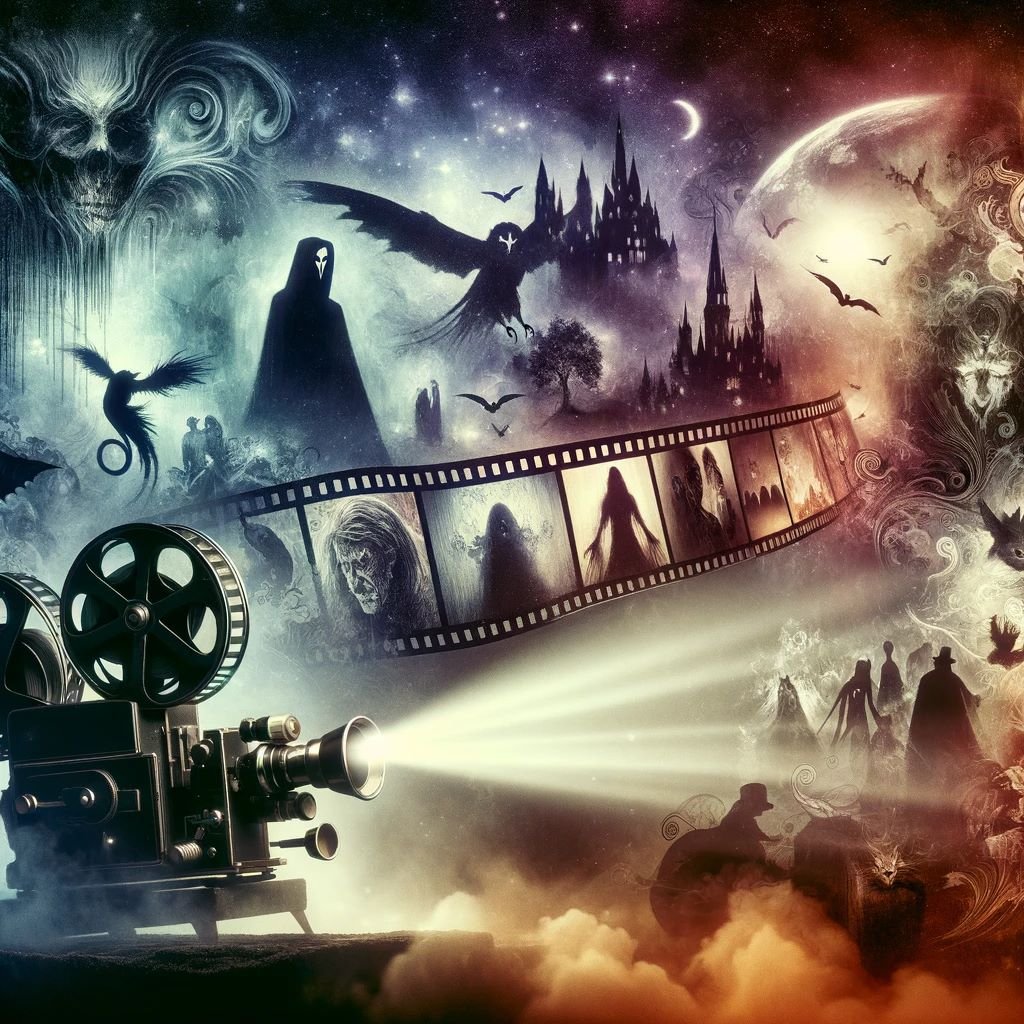Flickering shadows on a screen, a chill down your spine, and that unmistakable feeling of being transported to another realm—welcome to the world of dark fantasy in film and television. It’s a place where the mundane meets the macabre, and every frame is a window into a world both terrifyingly alien and uncomfortably familiar. But what is it about these dark tales that glue us to our seats, eyes wide, hearts racing? Let’s dim the lights, grab some popcorn (or a comforting blanket), and delve into the eerie allure of dark fantasy on the big and small screens.
Setting the Stage: Dark Fantasy’s Cinematic Roots
The haunting allure of dark fantasy has not just been confined to the pages of novels and stories. It has found a vibrant and visually stunning life on the silver screen. From the early echoes of the eerie in gothic horror films to the sprawling epics of modern cinema, let’s explore how dark fantasy has evolved and thrived in the world of film.
The Early Echoes of the Eerie: Gothic Beginnings
Tracing back to the gothic horror films of the early 20th century, dark fantasy has always had a haunting presence in cinema. These early films, with their fog-laden moors, haunted castles, and atmosphere thick with dread, set the stage for a genre that thrives on creating an immersive and intriguing world. They weren’t just movies; they were gateways into realms of shadow and mystery, inviting audiences to step into the darkness and explore the unknown.
The Monsters of the Silver Screen
The early icons of horror cinema, like Dracula, Frankenstein’s monster, and the Wolf Man, did more than just scare audiences. They introduced a world where the fantastic and the frightful intertwine seamlessly. These creatures of the night didn’t just haunt dreams; they laid the groundwork for the complex and captivating narratives of dark fantasy to come. They showed that monsters could be more than just villains; they could be tragic figures, anti-heroes, or symbols of deeper societal fears.
The Evolution of Enchantment: From Page to Picture
As the literary world of dark fantasy grew and evolved, so did its cinematic counterparts. Film adaptations of beloved dark fantasy novels and stories brought these complex worlds and morally ambiguous characters to vivid life. Movies like “The NeverEnding Story” and “The Dark Crystal” transformed the way audiences experienced these tales, turning them from whispered stories into sprawling visual spectacles. These adaptations expanded the genre’s reach and impact, bringing it to a wider audience and cementing its place in the cultural imagination.
The Blockbusters and Cult Classics
Over the years, dark fantasy has given us both box office hits and cult classics, proving its versatility and enduring appeal. Epic narratives like “The Lord of the Rings” trilogy have shown that dark fantasy can be both grand and deeply personal, while films like “Pan’s Labyrinth” have explored the surreal and symbolic aspects of the genre. These films and shows have left an indelible mark on popular culture, showing that dark fantasy can be as rich and complex on the screen as it is on the page.
The Legacy and Lore of Dark Fantasy in Cinema
As we look back at the cinematic roots of dark fantasy, it’s clear that this genre has always been about more than just scares and spectacle. It’s a realm where the psychological and the fantastical meet, where the monsters we face are often reflections of our own inner demons. From the gothic beginnings to the modern blockbusters, dark fantasy in cinema has continued to evolve, constantly finding new ways to captivate and challenge audiences. As it moves forward, it promises to continue pushing boundaries, exploring new depths of the human psyche, and inviting us all to gaze a little longer into the gloom.
The Mirror of Morality: Themes and Symbolism in Dark Fantasy Media
In the shadowy realms of dark fantasy media, the lines between the real and the unreal blur, offering a reflective surface that reveals much about our world and ourselves. Films and television shows in this genre are more than mere entertainment; they’re canvases for exploring deep themes and intricate symbolism. Let’s delve into how these narratives act as mirrors of morality, reflecting the real in the unreal.
Reflecting the Real in the Unreal: Society’s Shadows on Screen
Dark fantasy films and shows serve as a mirror, reflecting our real-world fears, anxieties, and societal issues. They delve into themes of power, corruption, identity, and the complexities of the human condition, all while cloaked in the supernatural and the mysterious. These narratives offer a way to confront and contemplate issues that might be too daunting to face directly, providing a fantastical lens through which we can examine and understand our world.
The Monsters Within
In dark fantasy media, the creatures and antagonists that haunt the screen are rarely just external threats. They often represent internal struggles, societal problems, and personal demons. Vampires might embody our fears of the unknown or the allure of forbidden desires, while ghosts could signify unresolved past traumas. These monsters make the horror both a literal and a figurative battle, one that resonates on a deeply personal level.
The Art of the Allegory: Visual Metaphors and Mystique
The visual nature of film and television allows dark fantasy to convey complex themes through rich symbolism and evocative imagery. A dark, twisted forest might not just be a setting but a representation of the protagonist’s troubled mind. A cursed object could symbolize an addiction, obsession, or a hidden past. Through these visual metaphors, dark fantasy media explores the nuances of human experience, drawing viewers into a world where every element is laden with meaning.
Archetypes and Anxieties
Dark fantasy draws heavily on archetypical characters and narratives, reimagining them for contemporary audiences. By tapping into these universal symbols — the hero, the mentor, the shadow — it connects with deep-seated fears and desires. These archetypes make the fantastical narratives feel personal and the personal struggles feel epic. They provide a familiar framework within which new, often unsettling stories can unfold, making the exploration of complex themes accessible and resonant.
Peering into the Abyss: The Impact of Dark Fantasy Media
Dark fantasy media does more than entertain; it invites introspection and understanding. It holds up a mirror to our society and ourselves, using the unreal to shed light on the very real. Through its exploration of deep themes, symbolic imagery, and universal archetypes, it offers a unique space for contemplating morality, humanity, and the myriad shades between good and evil.
As we engage with these narratives, we’re not just passively watching; we’re actively interpreting, reflecting, and learning. The monsters and magic, the heroes and villains, all serve a greater purpose: to illuminate the complexities of the human heart and the world it inhabits. In the mirror of dark fantasy media, we see not just the shadows of our society but the light of understanding and empathy, shining through the gloom.
Future Visions: The Evolving Landscape of Dark Fantasy on Screen
The realm of dark fantasy on screen is undergoing a remarkable transformation, driven by new technologies, shifting audience expectations, and a growing recognition of the genre’s potential. As we look to the future, several trends and transformations are set to redefine how we experience these shadowy narratives. Let’s explore what lies ahead for the evolving landscape of dark fantasy on screen.
Trends and Transformations: The Rise of Streaming
The advent of streaming services has revolutionized the way we consume dark fantasy. Platforms like Netflix, Amazon Prime, and Hulu have become the new homes for innovative storytelling, allowing for greater creative freedom and risk-taking. Shows like “Stranger Things” and “The Witcher” have not only garnered massive followings but also showcased the genre’s ability to captivate audiences with complex, episodic narratives. Streaming has also made dark fantasy more accessible, allowing viewers to immerse themselves in these worlds at their own pace, fostering a deeper and more personal connection to the stories.
Diversity and Depth
As the audience for dark fantasy continues to expand, there’s a growing demand for narratives that reflect the diversity of the real world. Future dark fantasy media is likely to feature a broader array of stories, characters, and cultural perspectives. This shift isn’t just about representation; it’s about enriching the genre with new myths, legends, and moral complexities. By exploring different cultures and viewpoints, dark fantasy can offer more nuanced and varied explorations of themes like power, identity, and morality. This trend towards diversity and depth will not only make the genre more inclusive but also more intriguing, providing fresh takes on classic tropes and expanding the scope of what dark fantasy can be.
Anticipating the Shadows: What’s Next for Dark Fantasy on Screen
The future of dark fantasy on screen is as mysterious and exciting as the stories it tells. Here’s what we might expect:
Innovative Storytelling: As technology advances, so do the possibilities for storytelling. We may see more interactive and immersive forms of dark fantasy, where viewers can engage with the narrative in new and unexpected ways.
Global Narratives: With the world becoming more interconnected, dark fantasy on screen will likely draw from a wider range of myths, legends, and folklore. This global perspective could introduce audiences to new monsters, heroes, and enchanted worlds.
Psychological Depth: As audiences crave more complex and challenging narratives, dark fantasy may delve deeper into the psychological aspects of its characters and stories. This could lead to more introspective and thought-provoking media, where the real horror lies in the characters’ minds rather than in external monsters.
The evolving landscape of dark fantasy on screen promises to take us on journeys to shadowy realms we’ve never imagined. With each new show, film, or interactive experience, we’ll explore deeper into the darkness, uncovering new fears, desires, and truths along the way. As we anticipate the future of this genre, one thing is certain: the shadows have never been more alive with possibility.
The Enduring Echo of Dark Fantasy in Media
As the credits roll on our exploration of dark fantasy in film and television, it’s clear that this genre is more than just a collection of spooky stories. It’s a reflection of our deepest fears and desires, a commentary on society, and a testament to the power of narrative to move and transform us. So, whether you’re a die-hard fan or a curious newcomer, remember that each dark tale you watch is not just entertainment but a journey into the heart of what it means to be human. The world of dark fantasy on screen is vast and varied, with countless tales waiting to be told. Which dark path will you follow next? The choice, dear viewer, is yours.






0 Comments